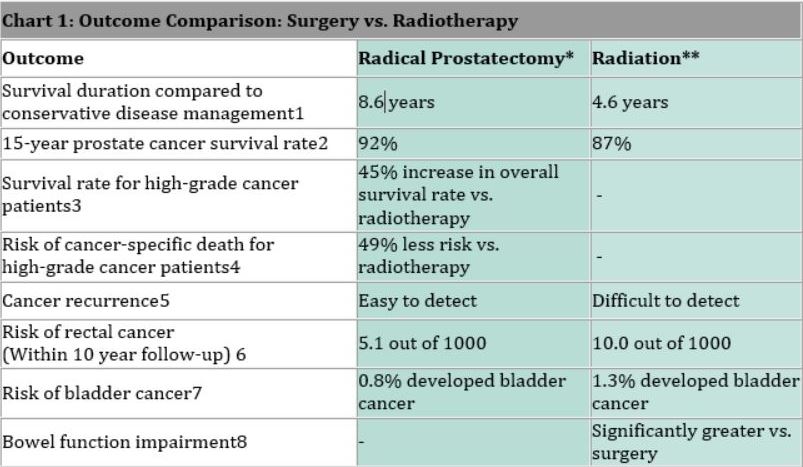
Treatment Comparisons
Prostate Cancer Treatment at Washington Township Medical Foundation
This page compares radical prostatectomy with radiation as treatment for prostate cancer. Radical prostatectomy as referenced in this chart includes all prostate surgery approaches including open surgery performed traditionally through a large incision, conventional minimally-invasive procedures, laparoscopic radical prostatectomy (LRP), and more. As this chart demonstrates clearly, radical prostatectomy offers patients numerous advantages over traditional radiology treatment, with higher rates of survival and success. Your urologist at Washington Township Medical Foundation will help you understand your options and the treatment plan that is right for your situation.

**External Beam Radiation Therapy (EBRT) unless otherwise noted in the citation.
*Open surgery; comparable long-term data not yet available on
da Vinci® Prostatectomy.
References for Chart 1:
[1] Tewari A, Raman JD, Chang P, Rao S, Divine G, Menon M. Long-term survival probability in men with clinically localized prostate cancer treated either conservatively or with definitive treatment (radiotherapy or radical prostatectomy). Urology. 2006 Dec;68(6):1268-74.
[2] Tewari A, Raman JD, Chang P, Rao S, Divine G, Menon M. Long-term survival probability in men with clinically localized prostate cancer treated either conservatively or with definitive treatment (radiotherapy or radical prostatectomy). Urology. 2006 Dec;68(6):1268-74.
[3] Tewari A, Divine G, Chang P, Shemtov MM, Milowsky M, Nanus D, Menon M. Long-term survival in men with high grade prostate cancer: a comparison between conservative treatment, radiation therapy and radical prostatectomy--a propensity scoring approach. J Urol. 2007 Mar;177(3):911-5. Erratum in: J Urol. 2007 May;177(5):1958.
[4] Tewari A, Divine G, Chang P, Shemtov MM, Milowsky M, Nanus D, Menon M. Long-term survival in men with high grade prostate cancer: a comparison between conservative treatment, radiation therapy and radical prostatectomy--a propensity scoring approach. J Urol. 2007 Mar;177(3):911-5. Erratum in: J Urol. 2007 May;177(5):1958.
[5] Di Blasio, C. J., A. C. Rhee, et al. (2003). Predicting clinical end points: treatment nomograms in prostate cancer. Semin Oncol 30(5): 567-86.
[6] Baxter NN, Tepper JE, Durham SB, Rothenberger DA, Virnig BA. Increased risk of rectal cancer after prostate radiation: a population-based study. Gastroenterology. 2005 Apr;128(4):819-24.
[7] Boorjian S, Cowan JE, Konety BR, DuChane J, Tewari A, Carroll PR, Kane CJ; Cancer of the Prostate Strategic Urologic Research Endeavor Investigators. Bladder cancer incidence and risk factors in men with prostate cancer: results from Cancer of the Prostate Strategic Urologic Research Endeavor. J Urol. 2007 Mar;177(3):883-7; discussion 887-8.
[8] Litwin MS, Sadetsky N, Pasta DJ, Lubeck DP. Bowel function and bother after treatment for early stage prostate cancer: a longitudinal quality of life analysis from CaPSURE. J Urol. 2004 Aug;172(2):515-9.
[9] Miller, D. C., M. G. Sanda, et al. (2005). Long-term outcomes among localized prostate cancer survivors: health-related quality-of-life changes after radical prostatectomy, external radiation, and brachytherapy. J Clin Oncol 23(12): 2772-80.
[10] Buron, C., B. Le Vu, et al. (2007). Brachytherapy versus prostatectomy in localized prostate cancer: Results of a French multicenter prospective medico-economic study. Int J Radiat Oncol Biol Phys 67(3): 812-22.
[11] Di Blasio, C. J., A. C. Rhee, et al. (2003). Predicting clinical end points: treatment nomograms in prostate cancer. Semin Oncol 30(5): 567-86.




